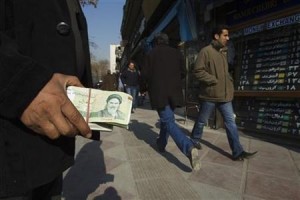 Jan 22 (Reuters) - The Iranian rial has dropped sharply on the open market since Sunday on speculation the head of the country's central bank could be sacked in a row over his performance that has exposed the country's political faultlines.
Jan 22 (Reuters) - The Iranian rial has dropped sharply on the open market since Sunday on speculation the head of the country's central bank could be sacked in a row over his performance that has exposed the country's political faultlines.Reuters�contacted currency traders who offered the rate of 35,400-550 to the dollar on Tuesday morning, little changed from Monday but down some 8 percent from Sunday when it stood at around 33,000.
Bank�governor�Mahmoud Bahmani - appointed by President Mahmoud Ahmadinejad in September 2008 - has faced strong criticism of his management of the rial following a slump in the currency last September that saw it lose 40 percent of its value in a matter of days.
He also faces claims of involvement in the "midnight withdrawal" affair of March 2012, when the central bank withdrew hundreds of millions of dollars from commercial�banks�without authorisation.
On Monday, Iran's Supreme Audit Court ruled that Bahmani should be dismissed from his post, news which appeared to send the rial into a new dip.
In what appeared a related move, Bahmani offered to resign on Sunday saying he wanted to retire but this was not accepted by Ahmadinejad.
Also on Sunday, parliament voted to investigate the central bank over its response to last year's currency crisis.
Analysts say the president cannot afford to show signs of weaknesses that could be used by his political rivals in parliament to undermine his position. Members of the Supreme Audit Court are recommended and approved by parliament.
The court ruling - which is not a binding decision on the government - was issued because of Bahmani's failure to attend a hearing and explain the reasoning behind the March 2012 withdrawals, Mehr news agency reported.
A separate report on the state news agency (IRNA) said that the�governor�had 20 days to appeal against it.
The central bank has said no such ruling was issued by the court and denies charges of any wrongdoing over the withdrawals.
Legislators have accused the central bank of economic mismanagement and failing to provide the market with enough dollars to meet demand, helping to drive down the rial.
To stem the September plunge in the currency, the government used security forces to arrest currency dealers and attempted to impose its own exchange rates.
The crackdown has made it difficult for many dealers to continue trading. Those that continue risk arrest and imprisonment as well as losses because of unpredictable swings in the market rate.
By Reuters
The Iran Project is not responsible for the content of quoted articles.










